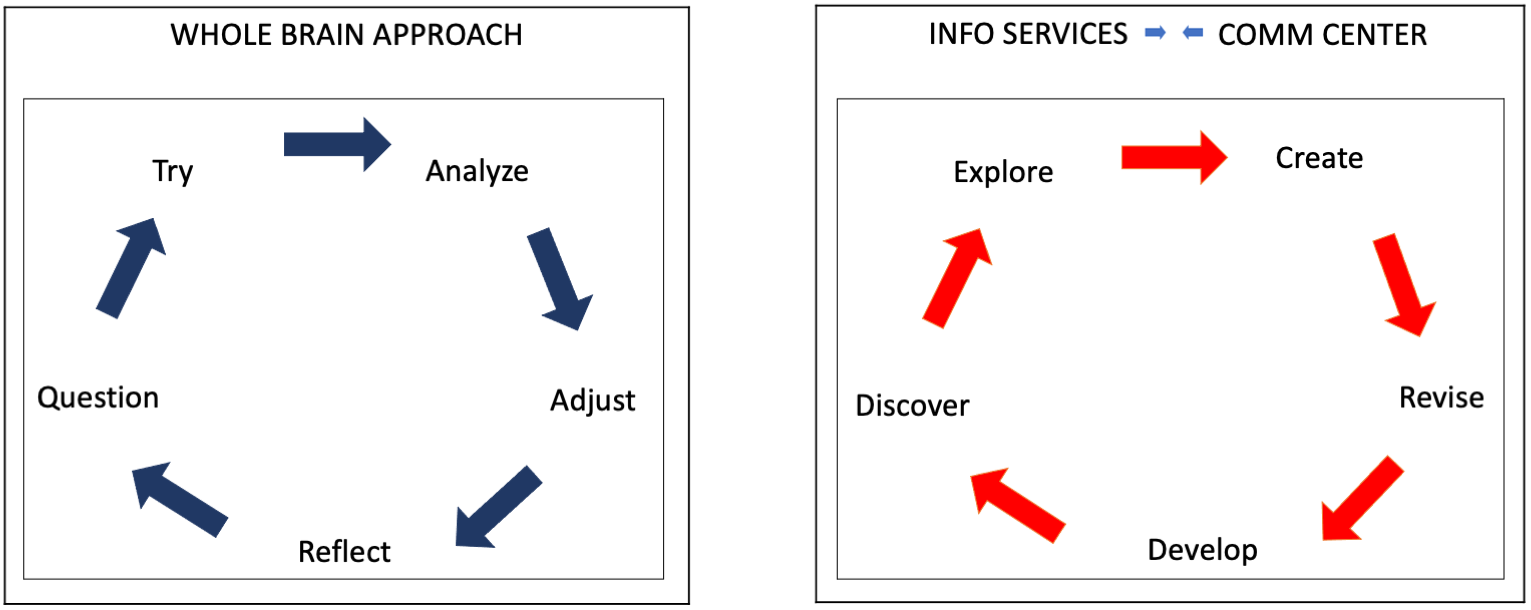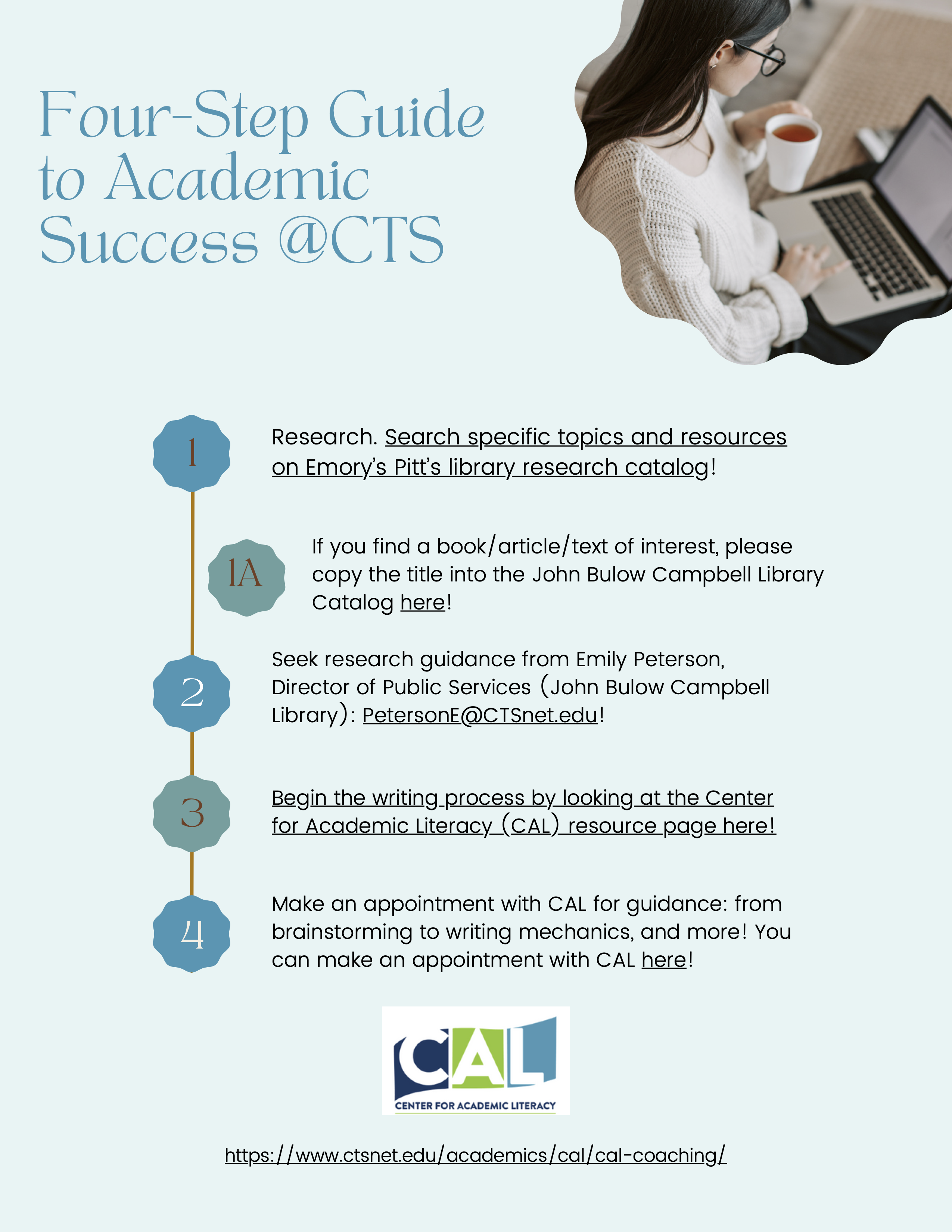Conversation Groups
Building Connections in the Library
Information Science and Communication Center Approaches for Student and Faculty Development
Abstract Building Connections among an Information Services Team in a theological library and a communication center housed in the same building can be beneficial to the academic pursuits of students and faculty at institutions that are both large and small. This conversation group focused on the critical work of Information Services and the communication center in building neural connections by stimulating the various lobes of the brain responsible for the research and writing process. Considering a whole brain approach, participants were introduced to ways in which Information Services and communication center staff can collaborate to assist with the academic pursuits of both faculty and students at their respective institutions.
To serve faculty, staff, and administration, and to promote the centrality of Information Services in the academic life of our institutions, theological libraries need to combine their resources and expertise to curate and facilitate the research process. The Atla Annual conversation group entitled “Building Connections in the Library: Information Science and Communication Center Approaches for Student and Faculty Development” examined the potential that Information Service teams provide for their institutions by looking at how intersections across Information Services can be maximized for the benefit of their schools.
At Columbia Theological Seminary in Decatur, Georgia, five units comprise Information Services, including: the Center for Academic Literacy (CAL1), Instructional Technology, Media Services, the John Bulow Campbell Library, and the C. Benton Kline, Jr. Special Collections and Archives. Each of these departments is aligned under the umbrella of Information Services to further the mission of the institution; united in the library as a hub and central point of departure for the teaching and learning activities of the seminary; and a safe space for nurturing and exploration. Given this context, the focus of the Atla Annual conversation group centered on (1) the collaborative process among Information Services and why this is important; (2) an examination of such collaboration from the perspective of a connectionist model of thinking; (3) the elucidation of the research and writing process by specifically examining the role of the library and the Communication Center; and (4) suggesting take-aways that participants could implement to foster connections among Information Services in their institutional settings.
Overview of Session: Why Collaboration Among Information Services?
As a trusted space on campus isolated from the pressures of the classroom or stressful interaction with other stakeholders on and off campus, the library, as a part of Information Services, possesses a unique position in which staff with a service attitude can support the campus community in their pursuits. The campus library is that quiet space where all can explore, hypothesize, and create without judgement. Within this setting, the task of Information Services is to build trust with the patron by looking out for their best interests in an environment that is non-threatening. Having a facility with a team of trusted experts to provide resources, allow for reflection and thought as well as promote the production and review of written and oral work under one roof is why collaboration in the library setting is so beneficial to the learning enterprise. This freeing environment permits patrons to use all their faculties in a constructive manner through the myriad number of perspectives and approaches to building knowledge that can be best explored in the library setting. Exploring such connections to enhance and support student and faculty pursuits was the conversation group’s main aim. To investigate this topic further, the overview for the Conversation session led to a more detailed examination of the process of knowledge acquisition through connectionism, answering the initial question of how knowledge is constructed and how connections among Information Scientists can assist with academic undertakings.
A Connectionist Model for Information Services
Considering the expertise offered by Information Services as a haven of connections with various paths, group discussion turned to the recent literature on brain-based teaching and learning (Harley 2010; Medina 2015). When considering the brain’s approach to learning (Murphy 2015), a key principle is based on the notion of connectionism, in which different lobes of the brain play particular roles in the learning process. Information Services personnel can stimulate the different areas of the brain, strengthening neural pathways that are the basis for research and writing. In this sense, connections are generated through the inputs provided and the resulting neural wiring that occurs. Considering the Whole Brain Approach to learning (Başar, 2006), when the student or faculty member comes to the library, the individual builds connections from both background knowledge (i.e., schema) as well as novel information that allow the person to identify past experiences that they are familiar with and build on these understandings to consolidate new knowledge. This use of schema is called scaffolding and is fundamental to the services intertwined within an Information Services web of support.
Connections with prior and current knowledge are thus at the heart of how the brain learns and makes sense of its surroundings. As Information Scientists, Librarian-teachers or scholars and Communication Center Coaches, we can aid the learner by facilitating connections, increasing attention, and building motivation—all part of a good learning foundation. To gain a more comprehensive understanding of this process, participants in the conversation group were introduced to the notion of schema, leading to questions about what schema is and how it can promote the learning process.
After posing the above questions, the group looked at a short video from the “Brain Rules” series in which Medina (2015) demonstrated the impact of schema when explaining the process of doing laundry. The participants were first introduced to schema by showing them a clip during which the presenters explained a process without giving clues about their presentation topic. At the conclusion of the video, participants were asked what they thought the video was about. There was confusion among the audience. When playing the clip a second time, the audience was provided with four words: “This is about laundry.” Suddenly, the video made sense and an example of schema was made clear.
In presenting the reasons why collaboration among Information Service Specialists is so important and after providing a framework for understanding how collaboration and schema can promote learning, the emphasis changed to looking at a model of the corroborative research and writing process between Information Services and the Center for Academic Literacy at Columbia Theological Seminary.
Collaboration for the Research and Writing Process
Combining Information Services with the offerings of a Communication Center relies on a multitude of expert perspectives to assist students and faculty. By employing different approaches that Information Service and Communication Center Specialists bring to student and faculty development such as strategies to create research questions, outline and draft, analyze data, edit, as well as reflect, one is drawing on all lobes of the brain to cement knowledge and fortify skills necessary for successful study and teaching. To address this conceptually, an illustration (see image 1) was presented to the conversation group, summarizing the sequence of connected services offered by research librarians by considering the Whole Brain Approach to learning and acquisition. The visual indicates how the collaboration with Info Services starts through discovery and exploration and is followed by creation, revision and development supported by the Communication Center. This Information Services collaboration promotes the skills used for academic inquiry as mapped onto the functions inherent to specific locations of the brain (i.e., from the frontal to the occipital lobes) according to the Whole Brain Approach (Başar 2006; Murphy 2015). In this regard, the connections established between the modules of the brain allow for learning to occur.

Image 1 The Whole Brain Approach to Learning: Info Services and the Communication Center
Discussion: Implementing Collaborative Activities for Students and Faculty
During the latter half of the conversation session, break-out groups were formed to discuss opportunities for building connections with Information Services as represented at the participants’ institutions. Among those at the session, some were smaller institutions with few resources while others were a bit larger and had a Communication Center, albeit one not connected with the library. Whatever the size of the school or the number of resources available, a variety of activities were proposed, including: (1) a teaching academy for faculty in which staff from Information Services and the Communication Center can assist with the development of a teaching portfolio, (2) classroom observation as well as (3) disseminating information for other instructional needs. Additional workshop suggestions pertaining to (4) feedback (e.g., giving and receiving correction or comments), (5) the research process, (6) assignment creation /curriculum development, (7) analyzing texts, (8) presenting and (9) classroom pragmatics were just a few of the areas in which Information Scientists and Communication Center staff could be of help. In addition, (10) bootcamps for writers on particular days or for an entire week during the academic year were suggested to provide therapy in which information scientists working together with communication center staff and faculty to assist patrons in overcoming writer’s block and setting daily and weekly project goals. Another suggested method to highlight the interconnected nature of information services with units such as a communication center included (11) the design of a Four-Step Guide to Academic Success as implemented at Columbia Theological Seminary. This guide (see image 2) provides a structured approach to using research resources, arranging consultations with librarians, exploring communication center resources specific to writing and presentation skills as well as booking appointments with academic coaches.

Image 2 Four-Step Guide to Academic Success at CTS
In creating this guide, Information Services at Columbia Theological Seminary not only emphasizes practical steps to academic success but also adheres to an institutional goal of using the entirety of the Seminary’s Information Services’ resources to support the breadth of academic skills necessary for the success of faculty and students in their campus roles as well as for their professional endeavors going forward.
Conclusion
The conversation group ended after 75 minutes with a promise to maintain correspondence among the participants in the form of email or via text messaging. With this goal in mind, the attendees showed a particular interest in creating a stronger Information Services presence on their campuses by building connections across their teams to serve the needs of faculty and students at their institutions.
References
Başar, Erol. 2006. “The Theory of the Whole-Brain-Work.” International Journal of Psychophysiology 60 (2): 133–38. https://doi.org/10.1016/j.ijpsycho.2005.12.007.
Harley, Thomas. 2010. The Psychology of Language. Newbury Park: Sage Publications.
Medina, John. Brain Rules: 12 Principles for Surviving and Thriving at Work, Home and School. Seattle: Pear Press, 2014.
Murphy, Robert. 2015. “Inquiry Learning.” Paper presented at the Annual International Korean Teachers of English to Speakers of Other Languages (KOTESOL) Association Conference. Seoul, ROK.
Endnotes
1 The Center for Academic Literacy (CAL) at Columbia Theological Seminary (Decatur, GA) is an academic support unit located within the John Bulow Campbell Library. The Center includes a Director whose Ph.D. is in Linguistics with a specialization in Second Language Acquisition and two academic coaches who are doctoral students in Religion and Philosophy respectively. In keeping with the needs of Columbia Theological Seminary, CAL is conceived as a Communication Center, assisting patrons with a broad array of language skills (e.g., writing, speaking, listening, reading, pragmatics) required for success in their academic and professional work on and off campus.